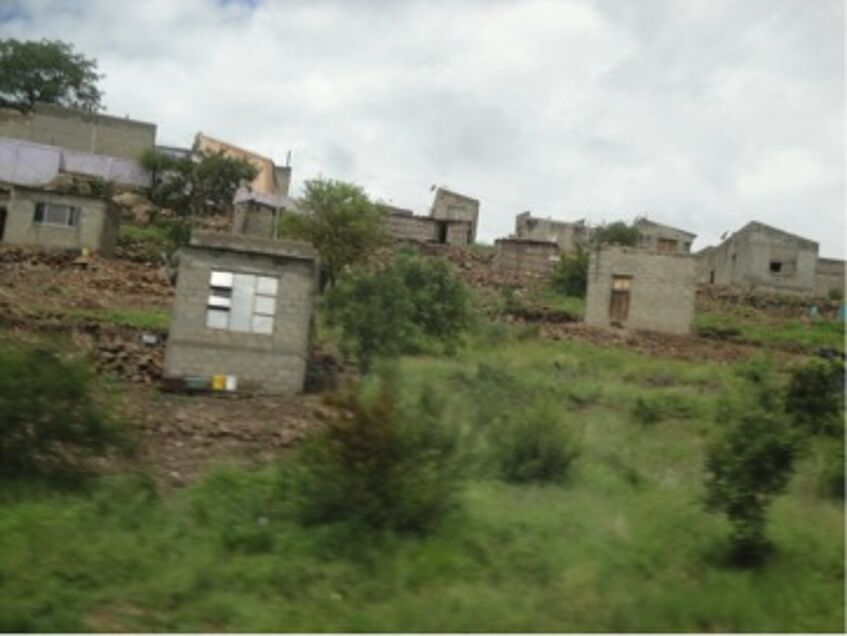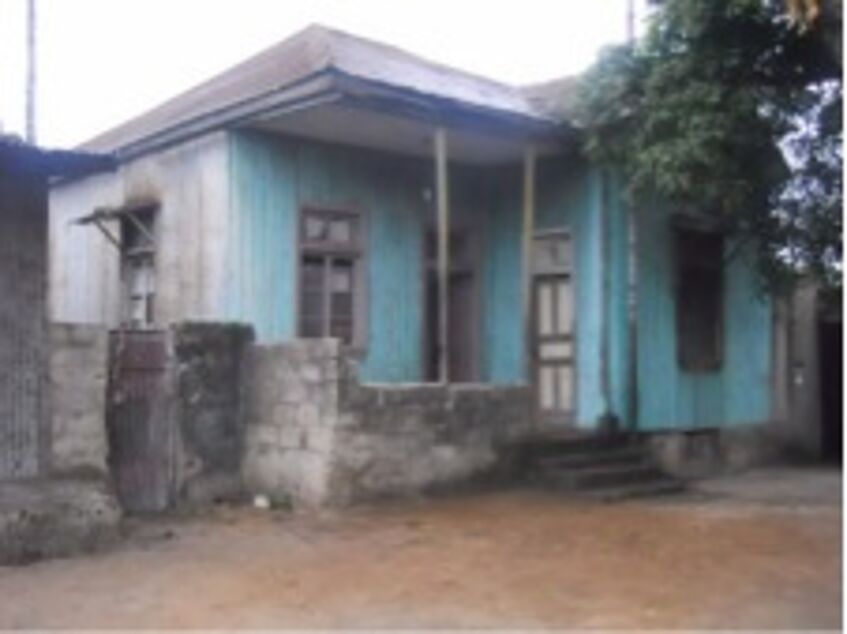Down, Down, Down

Houses for workers crossing from Garcia Ressano into South Africa – without permanent visa. The photo was taken through the window of the bus while we were leaving the border site – hence it is blurred. Only after we had walked through Mafalala some days later I learnt that such houses would probably be called “one water houses”.@Kirsten Rüther

This photograph was taken from the blog: mosanblog.wordpress.com/tag/dancas-tradicionais-em-mocambique/
It is a house where the revolutionaries met and – easy to detect: a multi-water house!

Vila Algarve – of decayed Mediterranean and Lusophone flair. It used to be a site of utter pain, of torture and death. @Katharina Gartner 20.02.2018
Down, Down, Down
Kirsten Rüther
Down, Down, Down from (Roof)-Top to Ground – Travel Notes about Houses and Housing in Mozambique
We were descending. Participating in a student excursion to South Africa and Mozambique we had finished the “South African part” of the programme, for which I had been largely responsible. I was sitting in the back of the coach. Feeling relaxed. Looking forward to getting into Mozambique.
From Johannesburg’s height of some 1,700 metres we had reached, in Mpumalanga, the terraced fields of Verlorenkloof. This is a farm, some 300 metres further below, where right on the slopes of the mountains, long before the trekkers arrived and long before the violent state building process of that area had started, the Bokoni people had been committed to innovate agriculture. The terraces were still there, the erstwhile houses all gone.
From Verlorenkloof we went further down, down, down, straight on the N4 and parallel to the railroad running into Mozambique, all the way along some huge commercial farms on which macadamia or eucalyptus trees were being cultivated. What a need for seasonal labour! And our tour guide told us that South Africans were angry about the many Mozambicans who claimed to be South Africans and who sometimes managed to get access to the housing the state was providing for its citizens.
Descending further. It was becoming hotter and more humid. Around midday we crossed over from South Africa into Mozambique at the Lebombo/ Ressano Garcia border station. Stamps into our passport. You are leaving South Africa. Entering Mozambique.
Lebombo/ Ressano Garcia border, less than 200 metres above sea level, is a busy site – for people on the move and engaged in multiple activities. Amongst a myriad of deals going on here, my eyes fell on a number of solid grey cement buildings, slightly elevated and somewhat withdrawn from the trading stores, foreign currency exchange kiosks and telecom shops. And oh no, it wasn’t the traders and shopkeepers who lived in those houses. These houses were for people who moved onto the South African side of the border on a daily, weekly or monthly basis. They were mostly unable to get long-term visa. So they lived on the Mozambican side while earning their living on the farms on the South African side. Unfortunately, as a member of a travelling group, I was unable to take a closer look at things. So it remained unclear to me, how these living spaces of grey cement houses actually work. Even though less colourful than the stores and kiosks, they did look more permanent. For human habitation. But not turned into “homes”.
We descended further. When turning into Maputo, which is low, low, low, on sea level, the coach took us through plains. We were watching corrugated iron structures and homes steeped in puddles of water. It had rained cats and dogs all through the weekend. The dirty water had flooded the houses. And yet, people seemed to be able to navigate those muddy spots. They waded through them. They scooped the water out of their buildings.
One day later there was terrible news. A huge rubbish dump has collapsed and killed 17 women, children and men. It is impossible to live on, or near, a garbage mountain – it buries you alive. I am reminded of a scene I watched, some time ago, in the South African movie Vaya. In that movie, one protagonist, a newcomer to Johannesburg, is threatened by his foes to live on a garbage heap should he not obey their orders and kill a man. It becomes eminently clear that to live by the garbage mountain would be below humanity, it would turn you into a person without social relations and without the hope to ever return to life again. No, you cannot “dwell” on a garbage dump. Neither in Johannesburg nor in Maputo. Perhaps you survive. But you may not.
My thoughts moved back from the world of movies to the real setting of Maputo. The city boasts of Mediterranean flair where once the colonially privileged population resided. Across the broad Avenida Marien Ngouabi there lies Mafalala. Mafalala has a different look. This is the neighbourhood where people lived who up until the achievement of Independence were not allowed to stay in the centre. During the colonial period it lay at the outskirts of town. Today, as Maputo has grown beyond recognition, it is located almost in the centre of the city. Entering Mafalala, we first walked through the “barrio” where, as long as Mozambique was not free, so-called coloured people used to put up their houses. Often they were labelled “assimilados” and represented a kind of buffer to the zone reserved for colonial residents – and this in addition to the broad Avenida! It was only behind that buffer that the “more African” parts of the place were situated. People had an interesting way of naming their houses in that place. Those who grew up in houses of status called their home a “two water house” or even a “three water house”, very rarely they lived in a “four water house”. Yet they all were better than the usual “one water house”. The terms were derived from the kind of roof a house had. If the rain ran down the roof in one direction it was a “one water house”. If, however, the roof parted the rain into two strands, and water came down on two sides, the house was a “two water” one. Only a few lived in a prestigious “four water” house – and wow! – this really must have been a symbol of achievement!
Apart from the Railway Company’s shop where every railway worker had to buy his supplies, all the structures in Mafalala were required to be of non-permanent material. What an enactment of power! Even today the former Railway Company shop stuck out in its façade painted in light blue. It was visibly different from the surrounding ones, two, three and four water houses in greyish outward appearance or coloured corrugated iron sheets.
And just as a note on the side: during our stay in Maputo our coach was parked around the corner of the hotel in front of the “Vila Algarve”. The Portuguese secret police (PIDE) used to have their headquarters here. They tortured countless people. This aspect of the building’s past was not immediately traceable on the outside of the Vila. It is a past people know about but not inscribed into the built structure. In fact, the building was reminiscent of Lusophone and Mediterranean style, with lots of blue tiles. One may find it picturesque at first sight. But what may people think of such architecture, more generally, which may be “beautiful” but which in that city represents oppression, torture and murder? I had no answer.
March, 2018
